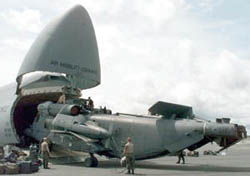

 เลือกภาษาไทย
เลือกภาษาไทย  | |
 |
Thai  เลือกภาษาไทย เลือกภาษาไทย |

 C-5 GALAXY | |||
| The C-5A GALAXY was the largest and heaviest aircraft in the world until introduction of the Russian AN-124 Rusland (NATO code name Condor) in 1982.
Four turbofan jet engines, high wing , T-tail , forward and rear cargo loading , 28 wheels sharing the load , and upward-hinged nose. The C-5 Galaxy manufactured by Lockheed-Geogia Co.
The Lockheed C-5 Galaxy is a heavy - cargo military transport aircraft to provide strategic airlift. The plane can takeoff and land in relatively short distances. Using the front and rear cargo openings, the Galaxy can be
loaded and off-loaded at the same time. Both nose and rear doors open the full width and height of cargo compartment, allowing drive-through loading and unloading. The troop compartment is located in the aircraft's upper deck. It is self-contained with galley, two lavatories, and 73 available passenger seats and two loadmasters. Another 267 seats may be installed on the cargo compartment floor. Normally, the C-5 does not carry troops in the lower-deck cargo compartment, exceptd for emergency or unusual situations. The forward upper deck seats a cockpit crew of six, a relief crew of seven, and eight mail or message couriers. The first Lockheed C-5 Galaxy flew on 30 June 1968 and lasted 94 minutes. Deliveries began in 1970. A total of 81 C-5 were built. The C-5A was powered by four General Electric TF39-GE-1 turbofan. In the mid 1970s , wing cracks were found throughout the fleet. All C-5A aircraft were restricted to a maximum of 50,000 pounds (22,680 kg) of cargo. To increase their lifting capability and service life, 77 of C-5A under went a re-winging program from 1981 to 1987. The last re-winged of C-5A was deliveried in July 1986. In 1982, the contract was awarded to Lockheed for a 50 of C-5B and that included the new wing, uprated TF-39-GE-1C turbofans, improved alloys and fasteners, and improved avionics system including Bendix weather radar with a color display. The first flight of C-5B took place on September 1985. Deliveries of C-5B began from january 1986 and deliveries all 50 of C-5B were completed in 1989. In 1980, NASA had two C-5As modified to carry space shuttle and its components. In each aircraft, the troop compartment's, located in the aft upper deck, was removed, and were given the new designation of C-5C. | | ||
| SPECIFICATIONS C-5 GALAXY | |||
| Engine (Four engines) | General Electric | TF39-GE-1C | |
| Engine Thrust | 41,000 -43,000Lbs | ||
| Length | 247 ft. 10 in. (75.3 m.) | ||
| Height at tail | 65 ft. 1 in. (19.8 m.) | ||
| Max. Takeoff Weight | 769,000 Lbs. (348,818 kgs) | ||
| Take off Distance | 12,200 ft. (3,697 m.) | ||
| Landing Distance | 4,900 ft.(1,485 m.) | ||
| Wing span | 222 ft. 9 in. (67.9 m.) | ||
| Speed | 541 mph (0.77 mach.) | ||
| Range | 5,940 miles (4,165 nm.) | ||
| Ceiling | 34,000 ft (10,303 m.) | ||
| Cargo Load | 291,000 Lbs (130,950 kgs) | ||
| Fuel Capacity | 12 integral wing tanks | 51,150 gallons (194,370 litrs) | |
| Crew | six | pilot,co-pilot,two flight engineers,two losdmasters | |
| Number of Seats | 73 passenger seats in rear upper deck 8 passenger seats in forward upper deck |
||
 |
cockpit C-5 Galaxy | ||
 |
Loading ; C-5 Galaxy | ||
| 1 nm.(nautical mile) = 1.15155 miles, 1 kt (knot) = 1.15155 mile / hr. 1 mach = 761 mph.(SL,ISA) | |||
© 2003 Thai Technics.Com All Rights Reserved | |||
| Contact Webmaster | |||